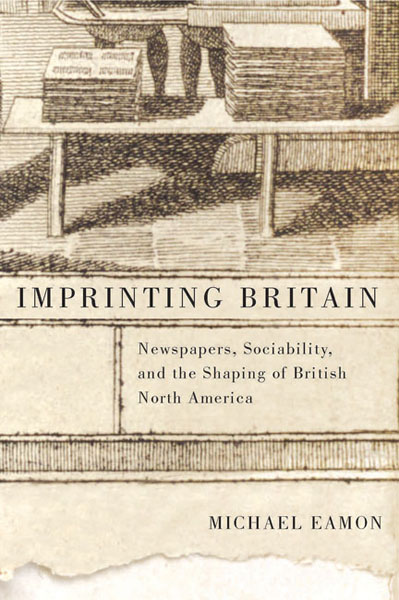Michael Eamon. Imprinting Britain: Newspapers, Sociability, and the Shaping of British North America. McGill-Queen’s Studies in the History of Ideas. Montreal and Kingston: McGill-Queen’s University Press, 2015. xxii, 263p., ill. ISBN 9780773544918. CAD$ 34.95 (paperback).
In Imprinting Britain, Michael Eamon “delves into the multivalent relationship that existed between the nascent English-language press in Halifax and Quebec City and its provincial audience” (xiii) to show how colonial print productions – above all a periodical press, broadly understood – served as a medium within which a British North American identity separate from that of the 13 colonies was shaped. On this promise, he largely delivers.
Eamon is at his best when he enters the archives. Drawing on a wealth of manuscript and primary print sources – his list of consulted primary sources takes up nearly half of his entire bibliography – he weaves a dense tapestry of interactions and bookish lives among the printers, readers, and writers of colonial Halifax and Quebec City. Eamon’s focus lies squarely on the production and circulation of newspapers in the region, with almanacs and magazines as supporting actors, to flesh out the inner workings of what he terms the “colonial print community, an eclectic group unified through [cultural] literacy and a shared belief in the potential of print to advance their social, intellectual, and economic interests. Participants in this informal collective also turned to print for advice regarding how to shape their behaviour, and believed in its capacity to influence the actions of others” (67).
To that end, the book is split into two sections. The first section reads “print as a form of sociability for those individuals who were part of the colonial print community” (xviii) and dedicates separate chapters to the printers, to those who contributed to and read the papers, to debates on propriety and the regulation of print sociability, and to the communication of popular science and “useful knowledge” (xix); while the second section investigates “the greater relationship between the printed word and other forms of colonial sociability” (xix) such as clubs and societies, the theater, and the coffeehouse, the last of which Eamon characterizes as “the physical embodiment of British tradition and gentility in the colonial capitals” (xx).
At times, though, Eamon assumes too much and shows too little when he identifies relationships and asserts meanings for his materials that would require more careful elucidation. He makes much of a “British tradition” on which the members of the colonial print community supposedly modeled themselves while adapting it to their colonial context, but it would have been useful, even necessary, if he had drawn out the subtleties and complexities of such connections more explicitly. This is not to say that Eamon is wrong, far from it: the claims ring true and could easily be shown to be securely founded in a careful analysis of the archival material that he is so good at unearthing and accumulating. In Eamon’s account, however, such an analysis is too often only implicit or assumed, conducted outside his narrative and the pages of his book, which leaves readers with a wealth of archival materials but an unfortunately disconnected set of conclusions about the broader historical and social significance of those materials. Such criticism notwithstanding, Eamon’s book is an invaluable resource: an important study of an underserved subject that fills a critical gap in scholarship on the sociology of print in colonial British North America and enriches our understanding of eighteenth-century transatlantic print ecologies.
Sören Hammerschmidt
Arizona State University


